I've been meaning to share with you some pictures and impressions of a new Yakitori (skewered and grilled chicken) shop in San Jose, but work has kept me busy, busy, busy.
All I seem to find time to do is to work, sleep, swim (I recently renewed my love for exercise in the pool), and go eat yakitori at Sumiya. I've found myself there three days in the last week. Yup, you read that right. Three days in one week...
The menu there is small, but the tsukune meat balls are superb. And the best part? All you can eat cabbage. Many restaurants don't serve enough vegetables for me (besides Hot Pot City with their all you can eat greens), but not Sumiya. They've got all you can eat cabbage. I literally turn into a little rabbit and happily much on raw cabbage.
In addition to various chicken parts (i.e. gizzard, skin, heart, liver, thigh, breast), Sumiya also serves Yakiton (non-chicken skewered and grilled items). The duck is OK, but the Beef Kalbi is tender, juicy, and full of charcoaled goodness.
Although I usually prefer my grilled items salted, I find myself liking the sauce (ta-re) version at Sumiya. I think their salt is too bitter to bring out the sweetness of the grilled goodies. Their sauce has a nice balance of sweet and savory.
Their ocha-zuke is a big two-thumbs up, made with a grilled onigiri rice ball soaked in their chicken stock. Although there is no ocha in their ochazuke, I think it's a nice finishing dish here.
I got some pictures to share, but since I went all the way to San Jose today for dinner, I won't be able to get to them tonight... Soon, soon!
5160 Moorpark Ave.
San Jose, CA 95129
(Lawrence Expwy & Moorpark Ave.)
Reservations: (408) 973-0604
Mon-Sat, 5pm - 11:30pm
Tuesday, July 25, 2006
Tuesday, July 18, 2006
Ramen Fever - Part II
I ran out of my favorite breakfast item a few days ago, and I've been scrambling in the kitchen every morning, trying to find something I wanted to eat... I've found myself eating the pseudo-fresh ramen packages for breakfast two days in a row, but it's just not the same anymore... I used to genuinely like those packets. But now... after my exposure to really high quality ramen in Japan... they just don't do anymore...
These pictures really don't do the ramen justice, but it's the best I could do with the Papa Bear's automatic camera and the strange yellow lighting at the Nagoya Men-douri ramen theme park. The theme park is made to look and feel like the mid-Showa period (~50 yrs ago?), and so the entire park has that yellow, old-school light-bulb kind of lighting...
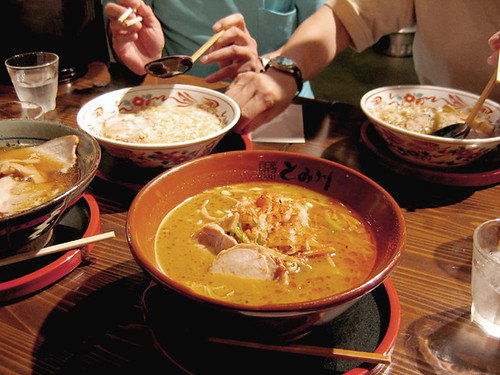
Seriously, Japanese ramen really has changed a TON in the decade I have been away from the Japanese ramen scene. I've been a big fan of ramen all my life, but my favorites were always the instant bowl kind (vs the instant cup ramen). I do remember how ramen shops were getting increasingly more popular with every short visit back to Japan - I distinctly remember one noodle shop that was so good a few years back, I had two bowls of the ramen back-to-back to the store keeper's surprise. Back then, though, it was the noodles that caught my appetite. Not until this last visit, did I get to try some of the supposedly best ramen soup - the new, powerful driving force behind the Ramen Fever in Japan.
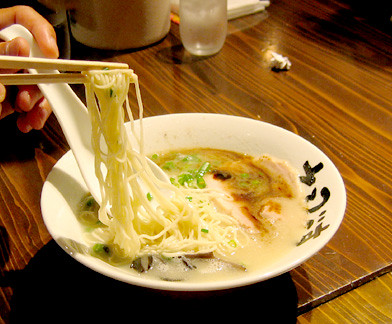
I've been following some of the Japanese ramen blogs, comics, and essays, and here is the gist of the story. Ramen shops started out with just making a simple stock for the noodles in Post-War Japan. Back then, the seasoning was the differentiating aspect for the shops. Then, the Hakata Tonkotsu Ramen Boom happened, and all these shops with mega-rich pork broth started popping up everywhere, redefining what a ramen soup should be like. As the ramen shops learned how to make powerful broth from all sorts of animal parts, the quality of the ramen soups improved drastically and more creative efforts were put into the noodles to match the soup better. Soon, the revival of the fish stock broth as a harmonious partner to the animal broth blossomed, and ever since then, ramen in Japan has become a culinary achievement like few others - quick, delicious fast-food meals where chefs carefully construct flavors, mixing and matching ingredients, toppings, spices, noodle textures, and anything else they can possibly think of changing to improve upon their ramen.
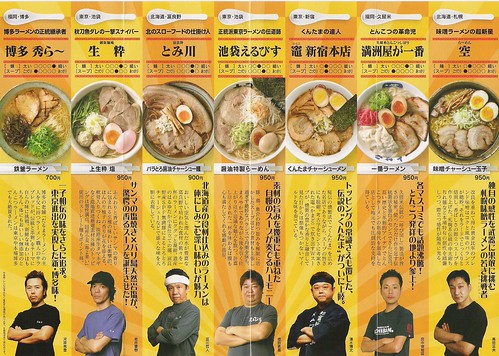
I only had enough appetite to sample two of the six ramen shops for a total of 8 bowls of ramen - 2 main bowls and 2 half-bowls for the four of us at two shops. The two shops differed in their strengths - the first shop being more noodle-focused and the second shop being very much soup-focused. Although I always thought I was a noodle-focused kind of girl, the soup at the second shop really blew me away. It was simply divine. The complexity of the Shoyu ramen soup was amazing - rich in deep flavors with that familiar warm undertone of the Japanese favorite dashi - fish and seaweed broth. I smelled the dried fish ever so slightly while the chicken and pork added strength that dashi never had. There was no hint of oiliness or heaviness, just deep, nourishing richness of a well made animal stock. No joke, I have never had soup so perfectly delicious to my palate before.
I learned a lot from that bowl of ramen - I think my soups are going to get better now that I have a clear idea of the 'most delicious' flavor... Although it's too hot now to spend hours infront of the stove, I think this winter is going to be a soupy winter!
These pictures really don't do the ramen justice, but it's the best I could do with the Papa Bear's automatic camera and the strange yellow lighting at the Nagoya Men-douri ramen theme park. The theme park is made to look and feel like the mid-Showa period (~50 yrs ago?), and so the entire park has that yellow, old-school light-bulb kind of lighting...

Seriously, Japanese ramen really has changed a TON in the decade I have been away from the Japanese ramen scene. I've been a big fan of ramen all my life, but my favorites were always the instant bowl kind (vs the instant cup ramen). I do remember how ramen shops were getting increasingly more popular with every short visit back to Japan - I distinctly remember one noodle shop that was so good a few years back, I had two bowls of the ramen back-to-back to the store keeper's surprise. Back then, though, it was the noodles that caught my appetite. Not until this last visit, did I get to try some of the supposedly best ramen soup - the new, powerful driving force behind the Ramen Fever in Japan.

I've been following some of the Japanese ramen blogs, comics, and essays, and here is the gist of the story. Ramen shops started out with just making a simple stock for the noodles in Post-War Japan. Back then, the seasoning was the differentiating aspect for the shops. Then, the Hakata Tonkotsu Ramen Boom happened, and all these shops with mega-rich pork broth started popping up everywhere, redefining what a ramen soup should be like. As the ramen shops learned how to make powerful broth from all sorts of animal parts, the quality of the ramen soups improved drastically and more creative efforts were put into the noodles to match the soup better. Soon, the revival of the fish stock broth as a harmonious partner to the animal broth blossomed, and ever since then, ramen in Japan has become a culinary achievement like few others - quick, delicious fast-food meals where chefs carefully construct flavors, mixing and matching ingredients, toppings, spices, noodle textures, and anything else they can possibly think of changing to improve upon their ramen.

I only had enough appetite to sample two of the six ramen shops for a total of 8 bowls of ramen - 2 main bowls and 2 half-bowls for the four of us at two shops. The two shops differed in their strengths - the first shop being more noodle-focused and the second shop being very much soup-focused. Although I always thought I was a noodle-focused kind of girl, the soup at the second shop really blew me away. It was simply divine. The complexity of the Shoyu ramen soup was amazing - rich in deep flavors with that familiar warm undertone of the Japanese favorite dashi - fish and seaweed broth. I smelled the dried fish ever so slightly while the chicken and pork added strength that dashi never had. There was no hint of oiliness or heaviness, just deep, nourishing richness of a well made animal stock. No joke, I have never had soup so perfectly delicious to my palate before.
I learned a lot from that bowl of ramen - I think my soups are going to get better now that I have a clear idea of the 'most delicious' flavor... Although it's too hot now to spend hours infront of the stove, I think this winter is going to be a soupy winter!
Monday, July 17, 2006
More for myself
It's 11:40 PM and I am still working! Urgh!
This post is really just so I can remember what I did when before my trip to Japan fades into a distant memory...
Day 1:
Dinner: Tempura at Yaegaki, Nagoya
Day 2: Travel to Nara/Kyoto
Breakfast: Assorted Ja-pan bread
Lunch: Over ten courses of tofu dishes in Nara
Dinner: Tawaraya Kaiseki
Day 3: Kyoto and head to Inuyama Onsen
Breakfast: Tawaraya's Kyoto specialty grilled fish
Lunch: Nishin soba (not Nissin as in the ramen maker, Nishin as in the Kyoto regional marinated fish...)
Dinner: U-kai bento and some ayu
Day 4: Back to Nagoya
Breakfast: Morning buffet at Inuyama Hotel
Lunch: Ramen festival
Dinner: Sashimi/sushi feast
Day 5: Last half day in Nagoya
Breakfast: Morning buffet at Nagoya Kanko Hotel
Lunch: Yakiniku at Toraji
Dinner: Assorted Ja-pan bread on the plane...
It's amazing I ate as much as I did and managed to lose some weight.
This post is really just so I can remember what I did when before my trip to Japan fades into a distant memory...
Day 1:
Dinner: Tempura at Yaegaki, Nagoya
Day 2: Travel to Nara/Kyoto
Breakfast: Assorted Ja-pan bread
Lunch: Over ten courses of tofu dishes in Nara
Dinner: Tawaraya Kaiseki
Day 3: Kyoto and head to Inuyama Onsen
Breakfast: Tawaraya's Kyoto specialty grilled fish
Lunch: Nishin soba (not Nissin as in the ramen maker, Nishin as in the Kyoto regional marinated fish...)
Dinner: U-kai bento and some ayu
Day 4: Back to Nagoya
Breakfast: Morning buffet at Inuyama Hotel
Lunch: Ramen festival
Dinner: Sashimi/sushi feast
Day 5: Last half day in Nagoya
Breakfast: Morning buffet at Nagoya Kanko Hotel
Lunch: Yakiniku at Toraji
Dinner: Assorted Ja-pan bread on the plane...
It's amazing I ate as much as I did and managed to lose some weight.
Sunday, July 16, 2006
Ramen Fever - Part I
Since it's a lot later tonight than I expected, I have to keep this post short...
But let me tell you, there are some serious food bloggers out there in Nagoya, Japan. My hometown of Nagoya is not particularly famous for ramen, but just a quick Google search for ramen blogs in Nagoya will bring a plethora of interesting sites.
Seriously, these guys eat one new bowl of ramen a day... And really good ramen too - this is not your Maruchan college instant noodles. This is a serious culinary movement in Japan - the Way of the Ramen.
They recently built an entire indoor 'theme park' in Nagoya, dedicated to ramen. Titled Nagoya Men-ya Yokochou (Nagoya Noodle Shop Corner), the shops in this park are run by guys who are serious ramen-freaks. From 6/24-8/31, they are having a spicy ramen festival, where all seven of the shops have created a new menu item - a spicy ramen - to combat the summer heat.
Luckily, when I was there, one of the shops was undergoing renovations/replacement, so I only had six shops to choose from - but let me tell you. Choosing the six shops in there was as challenging as trying to decide on the best meals in San Francisco. Some noodle shops play up their noodles made with special water, while other shops emphasize their soups made with the new, trendy double-soup method: two soup stocks - one that is usually seafood-based and one that is land animal-based, separately made and mixed in the bowl right before serving to bring out the best combination of broths and flavors.
But that's all I can handle reporting now...
More coming tomorrow~!
But let me tell you, there are some serious food bloggers out there in Nagoya, Japan. My hometown of Nagoya is not particularly famous for ramen, but just a quick Google search for ramen blogs in Nagoya will bring a plethora of interesting sites.
Seriously, these guys eat one new bowl of ramen a day... And really good ramen too - this is not your Maruchan college instant noodles. This is a serious culinary movement in Japan - the Way of the Ramen.
They recently built an entire indoor 'theme park' in Nagoya, dedicated to ramen. Titled Nagoya Men-ya Yokochou (Nagoya Noodle Shop Corner), the shops in this park are run by guys who are serious ramen-freaks. From 6/24-8/31, they are having a spicy ramen festival, where all seven of the shops have created a new menu item - a spicy ramen - to combat the summer heat.
Luckily, when I was there, one of the shops was undergoing renovations/replacement, so I only had six shops to choose from - but let me tell you. Choosing the six shops in there was as challenging as trying to decide on the best meals in San Francisco. Some noodle shops play up their noodles made with special water, while other shops emphasize their soups made with the new, trendy double-soup method: two soup stocks - one that is usually seafood-based and one that is land animal-based, separately made and mixed in the bowl right before serving to bring out the best combination of broths and flavors.
But that's all I can handle reporting now...
More coming tomorrow~!
Thursday, July 13, 2006
The Taste of Summer: Hamo
Hamo (pike conger, pike eel, Muraenesox cinereus) was in full force during this trip to Japan!
I grew up loving Hamo in Japan. Being from Nagoya, we really did get to enjoy the best of both worlds - Kansai (Western) and Kanto (Eastern) treats graced our tables with equal frequency. Although Tokyo-ites may eat more like Kyoto-ites, the height of Japanese cuisine is at Kyoto for me. Because Kyoto is not near any seaside ports and lacked the general availability of fresh fish, they had to be creative in their culinary styles and techniques to compensate for their lack of fresh ingredients.
Hamo is the perfect example.
Hamo was one of the few fish that could be transported from the ports to Kyoto alive. Unfortunately, hamo is also full of bones. I mean - FULL of bones. There is no way one can slice a piece of hamo into nice, clean sashimi bits. So, what did they do in Kyoto? They created a new way to eat fish.
Known as hone-giri (bone-cutting) technique, hamo is prepared by mincing the bones but not the skin of the fish. The chefs work on the fileted fish with great care and concentration as they slice the bones into pieces while maintaining the general structure and skin in tact. When the fish is fresh, the resulting flesh opens up like a flower into a gorgeous white bloom when blanched - perfect Botan (Peony hamo).
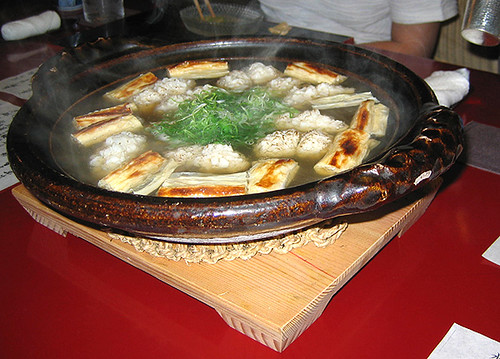
We had Hamo in Kyoto as a nabe (hot pot). In a perfect, pristine, clean broth, the hamo and grilled negi (green onion-ish leek-ish scallion) was a match made in heaven. The sizzled grilled fragrance of the sugar from the negi accentuated the delicate flavor of the hamo. The soft hamo flesh and its slightly chewy skin contrasted the multiple layers of the negi, each bite offering a different sensation.
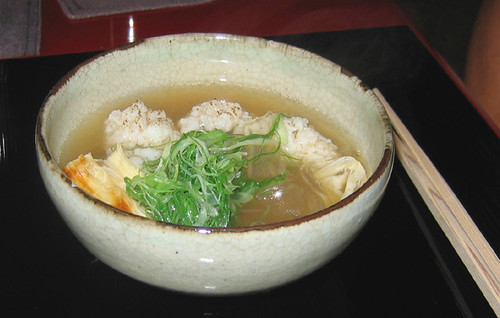
But the truth is, I preferred hamo prepared differently. I hate to admit it, but I am not as adventurous as I like to be. I like familiar foods and familiar tastes. I like to adventure, but I still like the same dishes I grew up with best. Here I was, sitting at one of the oldest inns in Kyoto, one of the oldest cities in Japan, eating one of the most traditional fish in Kyoto, and I was wishing for the hamo I grew up with in Nagoya!
In Nagoya, we always had hamo in a more traditional way - blanched and served with a ume (plum) sauce. We did have hamo again later in Nagoya cooked that way, but that is a story for another night...
I grew up loving Hamo in Japan. Being from Nagoya, we really did get to enjoy the best of both worlds - Kansai (Western) and Kanto (Eastern) treats graced our tables with equal frequency. Although Tokyo-ites may eat more like Kyoto-ites, the height of Japanese cuisine is at Kyoto for me. Because Kyoto is not near any seaside ports and lacked the general availability of fresh fish, they had to be creative in their culinary styles and techniques to compensate for their lack of fresh ingredients.
Hamo is the perfect example.
Hamo was one of the few fish that could be transported from the ports to Kyoto alive. Unfortunately, hamo is also full of bones. I mean - FULL of bones. There is no way one can slice a piece of hamo into nice, clean sashimi bits. So, what did they do in Kyoto? They created a new way to eat fish.
Known as hone-giri (bone-cutting) technique, hamo is prepared by mincing the bones but not the skin of the fish. The chefs work on the fileted fish with great care and concentration as they slice the bones into pieces while maintaining the general structure and skin in tact. When the fish is fresh, the resulting flesh opens up like a flower into a gorgeous white bloom when blanched - perfect Botan (Peony hamo).

We had Hamo in Kyoto as a nabe (hot pot). In a perfect, pristine, clean broth, the hamo and grilled negi (green onion-ish leek-ish scallion) was a match made in heaven. The sizzled grilled fragrance of the sugar from the negi accentuated the delicate flavor of the hamo. The soft hamo flesh and its slightly chewy skin contrasted the multiple layers of the negi, each bite offering a different sensation.

But the truth is, I preferred hamo prepared differently. I hate to admit it, but I am not as adventurous as I like to be. I like familiar foods and familiar tastes. I like to adventure, but I still like the same dishes I grew up with best. Here I was, sitting at one of the oldest inns in Kyoto, one of the oldest cities in Japan, eating one of the most traditional fish in Kyoto, and I was wishing for the hamo I grew up with in Nagoya!
In Nagoya, we always had hamo in a more traditional way - blanched and served with a ume (plum) sauce. We did have hamo again later in Nagoya cooked that way, but that is a story for another night...
Subscribe to:
Comments (Atom)